Design and Construction
Waterway infrastructure Design, Construction and Monitoring
AFPS has extensive fish passage experience having designed and constructed over 100 fishways and waterway enhancement projects in the last 20+ years. AFPS has complete design and construction experience for small fishways such as rock-ramp, bypass, culvert and vertical slot fishways and has contributed to the design of many large technical fishways including fish lifts and locks. AFPS developed the precast concrete cone fishway which is proving highly successful in waterways in both Australia and South-East Asia.
AFPS have undertaken a wide range of fish habitat rehabilitation projects throughout eastern Australia including the installation of fish habitat into streams, design and construction of erosion control structures that enhance fish habitat and the relocation of streams due to road construction.
AFPS specialises in leading and managing all aspects of fish passage projects from concept design through to construction but can also provide design and Waterway Barrier Works advice for those who have construction covered.
Stakeholder Engagement
Ensuring that stakeholders and the local community are engaged in any project is essential. Successful engagement will ensure the long-term success of the project. AFPS staff have successfully been engaging with the recreational and commercial fishers and non fisher stakeholders and local community. This has led to the implementation of over 70 projects.
AFPS can provide:
- Fish barrier assessment
- Fish community monitoring
- Development Approval and Waterway Barrier Works (QLD) advice and/or lodging
- Fish passage design
- Fish habitat design
- Project Management
- Construction of fishways
Types of fishways that we build

Rock Ramp Fishways
Rock ramp fishways are commonly used for low barriers up to about two metres high. They are essentially a series of rock ridges placed immediately below a barrier, creating a series of stepped pools that simulate a rocky stream bed. Each of the rocks placed on the ridges has a gap between them, through which the water flows, allowing fish to move from pool to pool and eventually past the barrier. The way that the rocks are placed, the gaps between them and the falls they create, are designed specifically for the unique fish community within the waterway to create conditions suitable for migration.
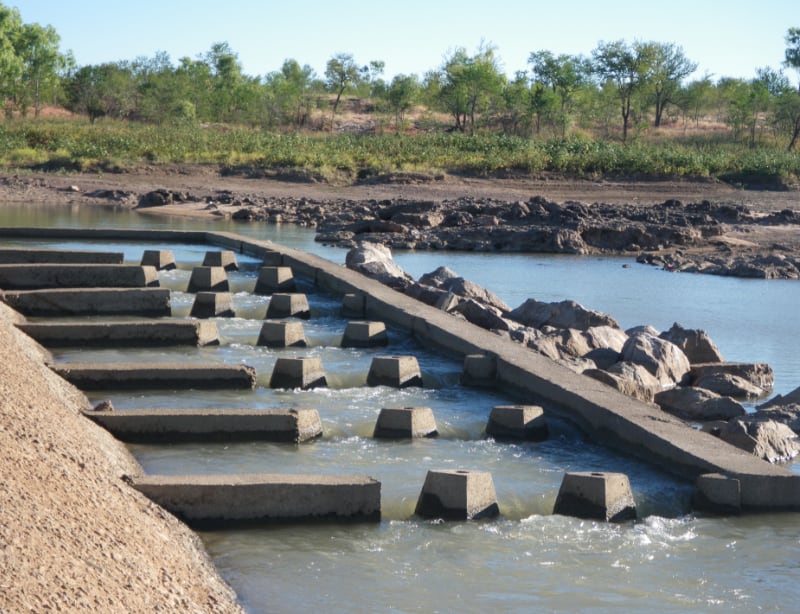
Cone Fishways
Cone fishways use a similar principle to the rock ramp fishway but uses concrete cones in place of rock to create the ridges. This design is particularly suitable for sites where the supply of rock is limited, or where flows need to be gauged. The concrete cones are used to create a series of ridges that provide a series of stepped pools with low turbulence and velocities through which fish can ascend. The concrete cones can be sized to suit any site, and can be pre-cast or cast on-site.
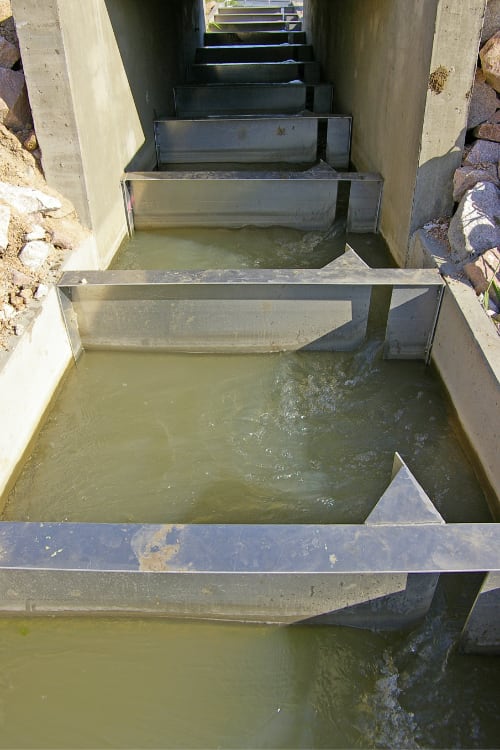
Vertical Slot Fishways
The vertical slot fishway design consists of a concrete channel extending from the top of the weir (headwater) to the base of the weir (tailwater), with baffles inserted at regular intervals along its length to slow the velocity of the water. Within each baffle there is a vertical slot through which water is transferred to the next pool downstream. This creates a series of pools and small steps, with low velocities that fish are able to swim through. The vertical slot fishway is one of the most successfully applied design worldwide but can have high capital costs.
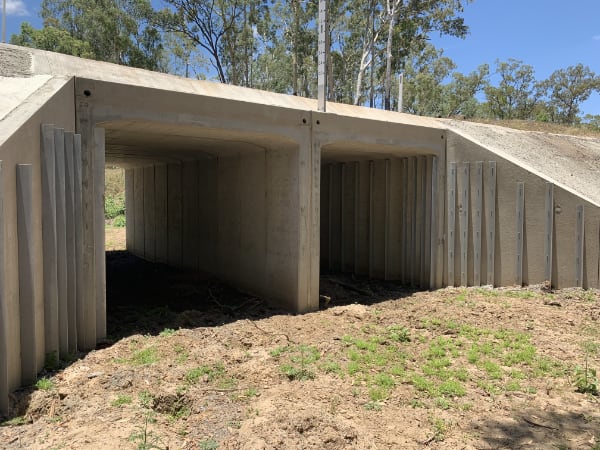
Fish Friendly Culverts
Fish-friendly culverts are characterised by box culverts that are installed below bed level with natural stream bed material forming the floor and that have a continuous low-velocity zone for fish migration throughout their length. This low velocity zone is typically achieved by the installation of baffles. Baffles are a set of vertical protrusions from the walls of a culvert that break up the water flow, slow the water down adjacent to the culvert walls and provide resting areas and migration pathways for fish. The baffles are usually made of steel and fixed to the wall with suitable materials. They work on the same principal as other fishways in that they break up the fast flow into a series of small steps with manageable velocities for fish. Fish-friendly culverts also ensure that there is no drop from the downstream apron to the water level by incorporating appropriate scour protection.
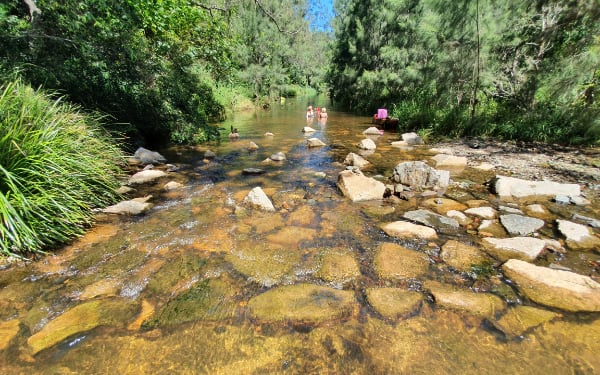
Fish Friendly Scour Protection
Fish friendly scour protection is typically used at culvert and bed level crossings to prevent scour occurring on the downstream side. Scour that occurs downstream of culvert aprons or crossings, can create a vertical barrier to fish passage during both low and moderate flows. Scour protection consists of a rock ramp or chute, that is constructed from different sized rock at differing depths that are locked together. The ramps abut the apron/crossings and are graded (sloped) appropriately to ensure that water velocity is sufficient for fish migration. The rock ramps may also include large protruding rocks to break up and diversify flows for fish migration.
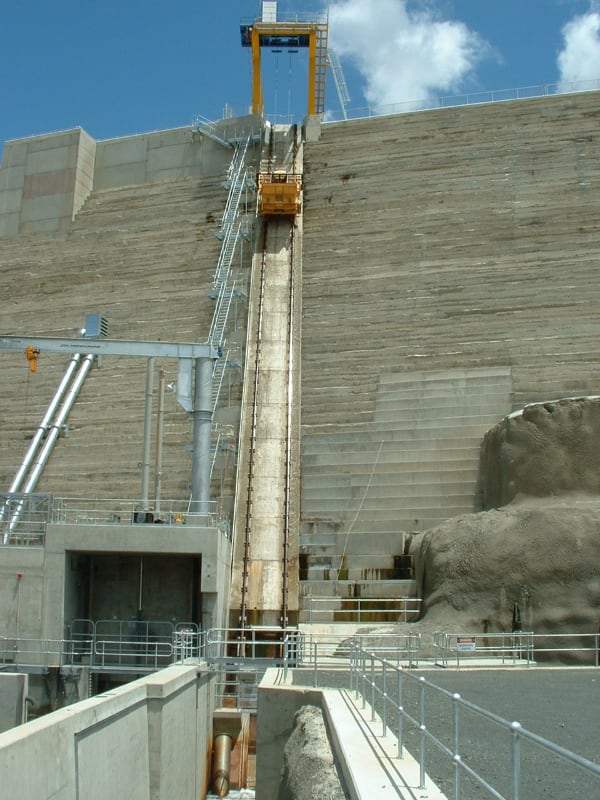
Fish Lifts
Fish lifts are most commonly used at large barriers higher than 10 m. The lifts utilise an entrance chamber that attracts fish to a hopper, which traps the fish and lifts them up and over the barrier, releasing them upstream. These fishways are highly technical and involve high costs.

Lock Fishways
Fish locks are used to move fish over barriers that are typically 5–15 m high. The operate in a similar way to a maritime navigation lock designed to move boats past barriers, with gates at the entrance, a holding chamber, and gates at the exit. Fish locks have four basic phases: attraction, filling, exit, and transition. In the attraction phase, the entrance gates are open to allow fish to enter the holding chamber. The entrance gates are then closed during the filling phase, then the exit gates open to allow fish to exit the chamber upstream of the barrier.